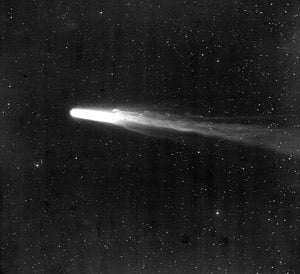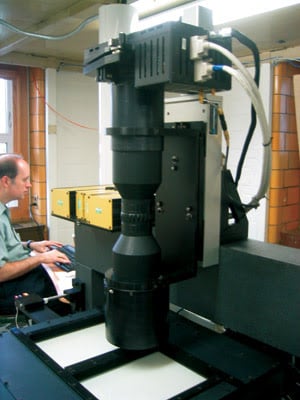A high-speed scanner is being used to create a digital database of more than 500,000 glass photonegatives.
Thomas L. Vogelsong and David W. Gardner, Salvador Imaging Inc., Robert J. Simcoe, Harvard College Observatory, and Jonathan E. Grindlay, Harvard University
From the early 1880s to the late 1980s, observers from Harvard College Observatory in Cambridge, Mass., took more than 500,000 astronomical images of the night sky from Harvard telescopes around the world. Most of that collection is stored at Harvard in the form of 8 × 10-in. glass photonegatives.
The plate collection represents at least 25 percent of the total cataloged and stored astrophotographs in the world and is by far the largest collection of its type. It contains, for example, a photo taken of Halley’s Comet in 1910 (Figure 1). However, in its current analog form, the collection is underutilized as a research database because modern computerized analysis tools cannot be used to examine it.

Figure 1. This image taken of Halley’s Comet in 1910 has been digitized from a plate in the Harvard College Observatory collection.
The Digital Access to a Sky Century from Harvard (DASCH) project was initiated to digitize the plates, making them more accessible to the international astronomy community. Unfortunately, high-end commercial scanners, most of which utilize linear imaging arrays, would require at least 20 min per plate and do not have the required accuracy or dynamic range.
At 20 min per plate, the current archive would take nearly 100 years to scan. The goal is to digitize all 500,000 plates within five years, which will require a scan time of less than 1 min per plate, including manually loading and unloading the plate from the scanner.
Other constraints include the need to preserve astronometric accuracy (star position and proper motion) and photometric accuracy (star magnitudes or brightness in an optical passband).
To address this need, Robert J. Simcoe and Jonathan E. Grindlay have developed, with NSF support, a specialized ultrahigh-speed, high-resolution digitizer. To achieve the required throughput, a large-area-scan SI-16M8-FF CCD camera from Salvador Imaging Inc. with a high readout rate was selected. The parallel light integration capability of its two-dimensional array of pixels provides several orders of magnitude increased scan speed over a linear-scan CCD. The throughput requirement is realized by reading out the entire 4096 × 4096-pixel image (32 MB) in 140 msec — a pixel rate of 160 megapixels per second.
The digitized images must have high fidelity. The camera allows accurate calculation of the bright-object centroid position to a small fraction of the pixel pitch (better than 0.2 μm) because its pixels have 100 percent fill factor. To capture the entire photodensity range of the original black-and-white photographs of 2.4 Dp to 3.4 Dp, the camera provides 12-bit acquisition, enabling a photodensity range of up to 3.6 Dp. In fact, the centroid position of even brighter objects can be obtained because of the increased image diameter with increasing object brightness.
With a 1:1 imaging optic, the 11-μm pixel size is adequate to ensure that no image resolution is lost during the scan and provides a well size (125,000 electrons) that supports true 12-bit digitization. The larger pixel size also is attractive because it keeps the archived file size manageable. Archival file size is critical because a single 8 × 10-in. plate digitized with 11-μm pixel resolution creates 750 MB of data. A 5.5-μm pixel size (common in consumer digital cameras) would quadruple this file size as well as require four times as many table movements. Even with 11-μm pixel resolution, the 500,000 plate archive will consume more than 1.5 PB.
The digitizer is based on an Aerotech ABL9000 air-bearing linear motor granite table customized for a travel of 460 mm in the X-direction and 380 mm in the Y-direction (Figure 2). The table can move 50 lb a distance of 25 mm in 350 ms and settle to within 0.2 μm of the desired position. The X-Y table moves a plate holder underneath the CCD camera with a low-distortion (0.01 percent) 1:1 telecentric lens that images the photographic plate as it is illuminated from below.

Figure 2. The DASCH digitizer contains a Salvador Imaging camera and a 1:1 telecentric lens.
Because the camera uses a full-frame CCD and has no mechanical or electronic shutter, illumination is accomplished with a pulsed LED, and exposure is adjusted by controlling the width of the light pulse. The light system consists of four LED arrays from Lamina, each with 117 LEDs in a 1-sq-in. area. The pulsed LEDs produce the light equivalent of a 150-W incandescent bulb and turn on and off in nanoseconds.
The scan pattern for each 8 × 10-in. plate takes 60 overlapping pictures, resulting in two complete images of the plate (1.4 GB of data in 45 s for each plate). Because it scans two plates at a time, the machine generates about the same amount of data in 90 s as is on a DVD for a typical 90-min movie.
The data is written to an array of disks operating in the RAID 10 (stripped and mirrored) configuration. Offline processing creates a mosaic image of the whole plate. Locations of stars on the plate are matched to star catalogs to identify them and the exact sky coordinates of the center of the plate. The isophotal diameter and density of each star image are measured and magnitudes calibrated from photometric catalogs now becoming available for most regions of the sky.
As the plates are digitized, computer analysis of this unique and accessible electronic database will allow the current (since ca.1985) digital record of the partial sky to extend back a full sky-century and provide the long-term context for current and planned digital sky surveys (e.g., the Large Synoptic Survey Telescope).
The collection may contain from 300 to 1000 images of any given area of the sky acquired over the past 100 years, which allows measurement of the variability of stars and quasars on timescales of hours to decades. In the past, painstaking visual analysis of but a small sample of the plate collection produced fundamental discoveries such as the cosmic distance scale, the period-luminosity relation for Cepheid variable stars (1912), and the optical variability of quasars (1962). Digitization will allow scientists to look much more thoroughly into this unique century of data.
Support is being sought to enable this full-scale DASCH project to be carried out and the full database (with access and analysis tools) to be posted online for use by the astronomy research community and the public.
Acknowlegments
We are grateful for the support of the National Science Foundation, through NSF Grant AST-0407380, which has enabled the development of the DASCH project thus far.
Meet the authors
Thomas L. Vogelsong is director of business development at Salvador Imaging Inc., Colorado Springs, Colo.; e-mail: [email protected].
David W. Gardner is president of Salvador Imaging Inc.; e-mail: [email protected].
Robert J. Simcoe is senior systems engineer at Harvard College Observatory, Cambridge, Mass.; e-mail: [email protected].
Jonathan E. Grindlay is the Robert Treat Paine professor of practical astronomy at Harvard University, Cambridge, Mass.; e-mail: [email protected].